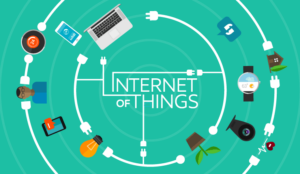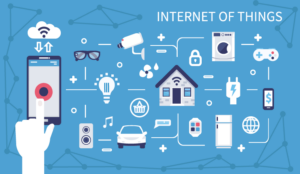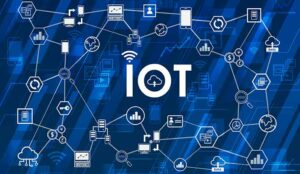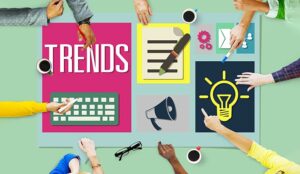Daniel Yin of RingCentral discusses the evolution of the Internet of Things (IoT) and how it can be used within your organization.
The Internet of Things, or “IoT” as it’s often known, isn’t as new as you’d think. Tech companies have been discussing the idea of connected devices for years. We even had our first connected toaster back in 1989.
Despite this, people are still trying to get to the bottom of a solid Internet of Things definition. People want to know how connected “things” can make their lives easier, particularly in the business world.
The term IoT, in its broadest sense, refers to everything that’s connected to the internet. However, if you ask someone, “What does the internet of things mean?” today, they’ll probably tell you that it’s all about objects that can “talk” with each other.
The IoT is made up of devices, whether it’s smartphones and tablets, or wearable tools. When you combine these connected devices to automated systems, artificial intelligence (AI), and the cloud, it’s possible to gather, analyse, and use data in a range of new and exciting ways.
In a sense, the IoT brings networks closer together, making sure that everything can work seamlessly on the same page. When your devices work more efficiently together, your people can begin to benefit from improved efficiency and productivity too.
Increasingly, we’re starting to learn that IoT isn’t just about connected appliances and smart homes – it’s about everything from smart cities, to improve collaboration in the workplace.
Here’s what you need to know about the many advantages of the Internet of Things.
The Evolution of the Internet of Everything
When we first began to explore the benefits of the IoT solutions and devices, it was in the consumer home.
We found that it was possible to connect devices to smartphones so that we could control thermostats and light bulbs from a connected app.
Manufacturers even began to experiment with things like intelligent fridges that could inform users when they were running out of crucial products like milk or eggs.
However, the IoT isn’t just a solution designed to connect the latest gadgets, like voice-activated smart speakers and automated locks. Instead, this technology is becoming an increasingly important part of building a more intelligent world.
The same circumstances that led to the explosion of smart customer gadgets, like wireless connectivity, better artificial intelligence, and universal cloud computing, have also prompted the next generation of industry development too. The “Internet of Everything” is appearing for the first time.
While the Internet of Things focuses on connecting devices, the Internet of Everything goes beyond that, by exploring connections that can be made everywhere, between people, data, and processes, as well as things. The Internet of Everything builds on top of IoT to further advance the power of the internet in improving business and societal outcomes.
Put simply, the Internet of Things is all about bringing people, processes, data, and things together, to make connections more valuable and relevant than ever before. This new solution turns information into viable actions that can create richer experiences, unprecedented economic opportunities, and advanced insights for companies.
In the world of IoE, everything is connected, not just people and objects.
Using IoT to Bring People and Data Together
As the discussion around the IoT continues to embrace the broader concept of the “Internet of Everything”, it’s becoming easier to see how IoT can bring people and data together.
When cloud communications and the IoT work together cohesively, collaboration begins to occur at an unprecedented level. Business processes are automatically enhanced, and people can make faster decisions based on real-time data and insights.
However, to truly take advantage of the IoT environment, we need a lot more than just sensors feeding data back into the cloud. The key to truly unlocking the advantages of IoT-based tools is to connect those sensors to communication and collaboration solutions through APIs. These middleware offerings can collect and analyse data crucial to the evolution of a business.
When team collaboration tools and IoT devices are brought together through the cloud, it’s possible for machines to start communicating more effectively with people, paving the way for genuine real-time reactions to IoT information.
For instance, in an emergency situation on the road, a car equipped with IoT technology could automatically send a distress signal back to a roadside assistance company. Without communication and collaboration technology, that signal would just be filed away into a database.
However, with the right cloud-based middleware in place, IoT can become less about just “collecting data” and more about using that information to make decisions.
The Benefits of Internet of Things Technology
As you can see in the examples above, IoT has the potential to transform the world as we know it. When used in the right environment, with the correct combined technology and middleware in place, IoT can make it easier for us to respond to events in real time.
With the IoT, people and objects can begin working more seamlessly together, taking advantage of things like:
1. Better Access to Data
We all know that data is the most valuable asset that a modern business can have. With IoT devices, it’s possible to gather more data faster than ever before.
Through sensors, business leaders can determine where their shipment is, check the health of their machines in real time, and even get better visibility into their field and remote workers.
All of this data makes it easier for managers and administrators to make effective decisions about how to run their business.
2. Improved Efficiency
The more data businesses can collect, the easier it is to improve operations in any environment. When you know what’s going on in your organization at a granular level, you can make relevant choices on how to run your company accordingly.
For instance, manufacturing equipment can alert humans when an impending breakdown is in progress so that engineers can be sent to the site instantly.
3. Increased Automation
The IoT also opens the door to opportunities that allow businesses to automate repetitive tasks in business.
IoT connected to the cloud and AI algorithms will enable machines to do much more work than they could ever have done before. This frees human beings to focus on more creative value-added work, rather than just crunching numbers.
4. Enhanced Productivity
Machines are generally capable of producing and managing data a lot faster than humans.
Factories that invest in IoT-enabled equipment can operate consistently because machines don’t need breaks. This means that companies can get more done, even when their human employees aren’t around.
The rise of IoT solutions can even help today’s companies to make better products and deliver stronger customer service experiences too.
The data you collect will ensure that you can see how customers are using products and services so that improvements can be made according to real-life insights and information.
Unlocking the Advantages of Internet of Things With Collaboration
As mentioned above, the key to making the most of the IoT is having the right systems in place.
Convergence between IoT devices and unified communications (UC) systems is becoming increasingly important in the modern landscape. The companies that can combine their collaborative strategies with IoT devices will see the biggest benefits.
For instance, IoT capabilities are appearing today in a wide range of products, from smartphones and smartwatches to video surveillance cameras, shipping crate sensors, and so much more.
The ability to collect data from countless streams via connected things brings a new value to every device. This means that companies can act in real time based on in-depth information.
With so much data to manage in the new connected world, IT teams need to think carefully about how they’re going to help employees deal with all that incoming information.
For many businesses, the solution comes from consolidating data streams from different devices and connecting that combined stream with an existing UC environment.
Thanks to APIs and integrations, it’s now possible to combine IoT alerts with automated recommendations that help employees to take instant action.
For instance, if a sensor on a cargo trailer sends an alert that something is wrong with the heat around temperature-sensitive products, the time that would have previously been required to find the right contact information for the people dealing with the truck could mean that the shipment would be in danger.
However, if the IoT system is connected to the existing communication and team collaboration tools that the business is using, things can happen in real time. The staff can monitor the system consistently and easily see what’s going on with internal and external temperatures.
In this case, if anything needs to be done to protect a shipment, people can react in real time, contacting a driver, sending instructions, and even delivering context via video conferencing.
If the issue becomes more complex, then the team collaboration tools can also ensure that business leaders can reach out to the right talent capable of dealing with that problem, wherever they may be. This could even include connecting with remote workers over video or sharing screens and data with contractors.
The Relationship Between IoT and Cloud Computing
In many different ways, the IoT is transforming how we live our lives. However, there’s a cost involved with all that added convenience and efficiency.
The IoT generates incredible amounts of data, which places a significant strain on any IT infrastructure. The only way to overcome this issue is to look for a solution that eliminates the pressure.
Fortunately, cloud computing, with its flexible and scalable structure, can help with this. The cloud not only helps to ensure that devices can work seamlessly together in the modern landscape, but it also makes sure that you have access to all the resources you need in a flexible environment.
Cloud computing and the IoT work together seamlessly to provide businesses with the space they need to grow and evolve in a data-rich world. With the cloud, companies tapping into IoT can:
- Minimize expenses by paying only for the computing resources that they use.
- Achieve greater economies of scale as an IoT provider
- Track and manage infrastructure needs consistently
- Increase speed and agility when it comes to accessing new resources
- Save money on operating data centres and high-bandwidth environments
- Deploy applications worldwide in a matter of minutes
In the years to come, some IT experts are also predicting the arrival of new cloud computing solutions for the IoT environment, like Fog computing, or Edge computing. This provides a way to gather and process information in local computing devices, rather than in a remote data centre.
Using this model, sensors and connected devices can send information to nearby Edge computing devices that can process and analyse data more effectively.
With around 5.8 billion IoT devices expected to be managed via Edge computing in 2020, the demand for this kind of structure is growing.
How Companies Are Leveraging IoT for Business Growth
Today, the IoT is powering enterprise transformation for governments, consumers, and enterprises around the world. Emerging technologies and tools like machine learning devices, smart speakers, and 5G are all changing the way that we interact daily.
The continued development of IoT is sure to be a significant force in the transformation of the workforce. By ensuring that we can connect modern-day devices to people and analytics, the IoT world makes businesses more efficient, productive, and informed. Here are some of the most common ways that businesses are already taking advantage of the benefits of IoT, AI, and even team collaboration tools to enhance conversions in 2019.
1. New Data Opens Avenues for Expansion
The more data that businesses can collect about their day-to-day operations, the easier it is for leaders to make informed decisions about the future.
Companies can analyse and track the performance of assets and people in production and assembly lines to make sense of how operations are flowing in the business environment. This makes it easier to find ways of improving performance and unlocking new opportunities.
For instance, if you notice that you have a bottleneck somewhere in your production cycle that makes it difficult to get products out to customers faster, you can implement new technology or hire skilled workers to overcome that issue.
2. Insights Into Customer Journeys
IoT also has a part to play when it comes to serving the demand for improved customer experiences. Today’s businesses are reliant on their ability to understand their customers and the journeys that they take through the buying cycle.
The IoT, combined with artificial intelligence, visual sensors, and more can provide greater insight into customer requirements and behaviour.
According to a report from Forbes, around 47% of companies say that they’re implementing visual analytics processes in their enterprise to capture information on situations and people.
For instance, in a retail environment, cameras could capture a customer’s reactions to a promotion that they see in person, or even use AI to assess a person’s sentiment when they’re at the checkout counter.
3. Transforming Customer Satisfaction
The evolution of IoT also has a role to play in changing the way that business agents and customers interact. Around half of the companies surveyed in the Forbes Insights survey above said that they’re using IoT specifically to improve their customer experience initiatives.
The reason that IoT is so valuable to customer experience is that it provides companies with data on how their clients make purchases and interact with businesses.
The data that teams can collect from customer touchpoints can provide a highly valuable insight into the experiences that people have whenever they interact with a company. This can lead to fantastic opportunities for businesses to tackle friction points before they arrive.
For instance, an IoT sensor in a retail environment could detect when a checkout becomes too crowded, thanks to growing queues in a store.
Once it detects a certain number of people present, it can automatically send an alert back to a team through a collaboration tool or application, asking for a new agent to open an additional till.
When IoT tools are connected with collaboration apps, the ability to improve customer experience can improve even more.
When everyone has access to the same alerts and tools on a cloud-connected collaboration device, teams can work more efficiently together to solve customer problems – no matter how complex they may be.
4. Improved Efficiency and Flexibility
Finally, the IoT also has benefits to offer in terms of flexibility and efficiency. The expansion of IoT and connected devices across various ecosystems within the modern business means that processes can become more digitized and simple.
Some companies are even investing in automation opportunities that allow them to eliminate the repetitive tasks that take up valuable employee time each day.
When repetitive tasks are automated, human team members can spend more time focusing on creative and complex challenges instead.
Efficiencies are realized as data begins to trigger automated actions in workflows without human intervention, meaning that companies can become increasingly more effective over time, without having to hire additional employees.
The possibilities of IoT are practically endless. However, for IoT to truly shine in the modern environment, it needs to be connected to the right processes and tools.

Daniel Yin
The teams that make the most out of their IoT environment will be those who go beyond connected things, into the realm of the Internet of “Everything”, where people, processes, and data are connected too. This means combining IoT solutions with everything from team collaboration tools, to automated analytics, and even artificial intelligence.
Author: Robyn Coppell
Published On: 12th Aug 2019 - Last modified: 14th Aug 2019
Read more about - Guest Blogs, RingCentral





































